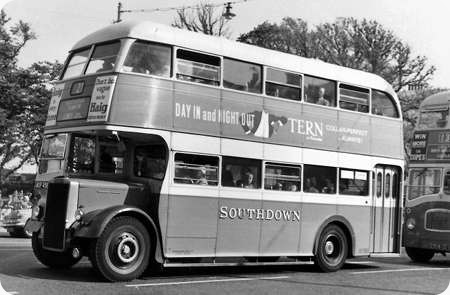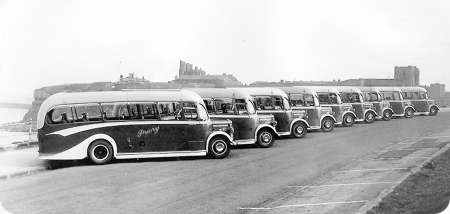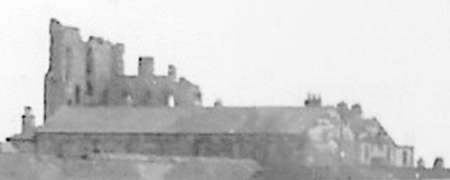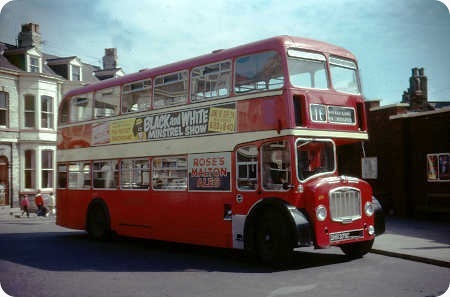
United Automobile Services
1965
Bristol Lodekka FLF6B
ECW H38/32F
The last time I posted one of my own photographs on site was the 14th of November 2010 which is three and a half years ago, now that was a very good run I think, thank you to all the contributors for keeping the site going. So as it as gone a little quiet it is back to my mostly Northern shots, the first being one of my favourite vehicles.
Seen in Scarborough bus station within the first few weeks of service a fine example of the Bristol Lodekka. These Lodekkas were powered by the six cylinder Bristol engine and boy could they go, especially down Burniston Road when on the Scholes Park Rd to Scarborough route I’m afraid I cannot remember the route number.
(After my beloved AECs) What could be better than a Bristol powered FLF? Well an FLF6B in Scarborough, of course. Some of my best holidays, and indeed some of my best days out, have been in Scarborough. (Only bettered by Whitby and Robin Hoods Bay – which are strangely now in the Borough of Scarborough). Much as I love East Yorkshire, Scarborough is in the North Riding and in United country. [I don’t care if you think I’m a bolshy old man. Traditional boundries do mean something.]
David Oldfield
15/05/14 – 07:28
Wonderful shot. These vehicles always looked so solid and well built. The Tilling Red ones always looked much better to me than the green fleets. The thing so fascinating about old bus photographs is the incidental stuff in the photos. The ‘Black & White Minstrel Show’ so politically incorrect by today’s standards and Roses Malton Ales. Bought out and killed off by Tetleys who in turn have been bought out and virtually killed off by Carlsberg!
Philip Halstead
15/05/14 – 09:49
Yes, Philip. You jogged a memory. The only time I ever saw the Black & White Minstrels live was at Scarborough – as was the only time I saw Tommy Cooper live. [Just like that!] Could be they looked solid and well built because they were, and I agree with you about Tilling Red.
David Oldfield
15/05/14 – 11:37
This is indeed a lovely shot of a handsome bus, set off nicely by that red livery. As a former West Yorkshire employee, I must confess to thinking that United’s livery had a slight edge over WY’s from the mid-sixties, when the latter started repainting its buses without the black edging between the red and cream. United retained the black edging and to me their livery then looked just ‘a cut above’. United’s later change to red-painted wheels rather than traditional black endeared me to the fleet even more. That said, both companies definitely maintained their own character, and as an enthusiast I still remained very loyal to West Yorkshire. David, I too must be a member (part time) of the ‘Bolshy Club’, as I know exactly what you mean about the importance of traditional boundaries. A friend who has lived in Newton-le-Willows all his life, still writes Lancashire on his address in correspondence. Newton is officially in Merseyside, but as he says, "it’s nowhere near the docks". At least the proud folk of East Yorkshire won their battle to have the county name reinstated, instead of the ridiculous ‘North Humberside’ inflicted in 1974. To many of us the roads around Scarborough and the rest of North Yorkshire just do not look right with turquoise buses traversing them instead of red ones, and neither do the roads in Co. Durham and Northumberland. Sorry folks, rant over!
Brendan Smith
15/05/14 – 17:46
Living in the bubble that was Sheffield with AECs (and Leylands) it was always a refreshing delight to go into Tilling land during holidays. Favourites were United and Lincolnshire but I had a soft spot for West Yorkshire when I happened that way – even more so when London journeys linked me up with WYRCC RELH6G coaches. I also remember a journey on the X43 (?) from Leeds to Scarborough by RE. I then sampled the delights of Western/Southern National when we holidayed in the West Country, as well as Bristol on the way down. […..and of course that bastion of AEC, Devon General.] Oh well, nostalgia is a sign of old age. Nurse? Nurse?
David Oldfield
15/05/14 – 17:46
It’s interesting that Brendan notes distinguishing features between United’s and West Yorkshire’s liveries, even though both were Tilling red/cream. I felt the same in the south in the early 60’s, with Wilts and Dorset and Thames Valley. Both were Tilling red, but there was something in "the look" which usually made a slight difference to the eye – Wilts and Dorset had cast fleet number plates, Thames Valley had painted numbers, for example. I felt the same about green Tilling companies, such as Hants & Dorset and Southern/Western National. As a teenager enthusiast, I sometimes felt that Tilling companies could be rather boring because of the similarities. But once NBC corporate livery appeared, boring took on a new definition – ’nuff said!
Michael Hampton
16/05/14 – 06:53
According to Bus Lists on the web, full production records exist for 1714 of these Bristol’s of which 164 were for United. However, another 300 or so were built where only partial records exist, and some of them went to United, so its not unreasonable to assume that the actual number they had would have been nearer the 200 mark. Several United depots ran services into Newcastle, and they always looked well cared for. I cant speak for other depots, but I know that the coaches based at Whitley Bay depot were always washed by hand.
Ronnie Hoye
17/05/14 – 16:03
A fine picture of a well-loved marque. I think the route number from Scholes Park Road at that time would be the 116 cross-town service from Scalby Village to Eastfield Estate. This stopped at Scholes Park Road end on Burniston Road as no service down to Scalby Mills existed at the time.
The Bristol FLF6B did in fact have a second coming in Scarborough in 1977. Chronic bus shortages in the United fleet for the Summer season in 1976 had seen the purchase of a variety of buses from other operators and Scarborough was blessed with some very decrepit MW6G’s from Crosville which thankfully only lasted a few months in to 1977 pending despatch to Barnsley. The shortages continued into 1977 and in June of that year United acquired four FLF6B’s from East Midland which became 545-548 in the fleet. Of these, Scarborough certainly had 546-8 – the PSV Circle records the withdrawal dates as 1/79 for 546 and later in 1979 for 547-8. My office window at the time faced onto Westborough (before pedestrianisation) and it was very obvious when 547 or 548 was dragging itself up the hill from the harbour terminus on service 106 to the Hospital which was a regular turn for these buses together with other town services. There was a bus stop right outside the office and therefore a variety of aural delights during the day. It was a rather incongruous situation whereby the delightful drone of an FLF could be followed by the raucous racket of a Mark 1 Leyland National! At the time, I lived at Cloughton Village some five miles out of Scarborough and on many occasions had need to use United service 114 into Scarborough. Up to 1978, this was a decent fast service due to an old agreement that out of town services could not pick up inbound within the Borough boundary which effectively meant picking up at Cloughton, Burniston and Scalby Villages was allowed but as soon the boundary was reached, ie Hackness Road end approx., then it was non-stop into Scarborough centre which was excellent. After the agreement was re-negotiated, it was much much slower due to many stops in the densely populated area within the borough.
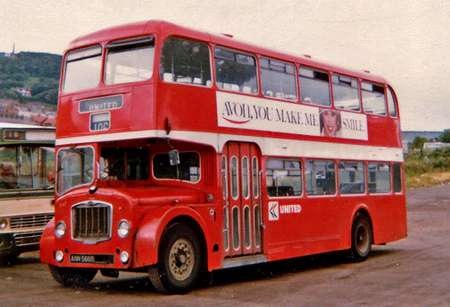
My photo is of 547 ANN 566B at Scarborough Westwood Coach Park in October 1979 shortly before withdrawal.
John Darwent
17/05/14 – 16:26
Thanks John my holidays in Scarborough were in from the mid fifties to the mid sixties. Every year we had a chalet on the North Bay at Scarborough, number 99 actually, and stay in a B&B in Langdale Rd, we had two ways to get back at night. Walk to the Corner Cafe (Waffle Shop) then up through Peasholm Park, Columbus Ravine to Langdale Rd. Or up the back of the chalet over the little train line on to Scholes Park Rd, walk to the top for the bus which was parked waiting in Scholes Park Rd, it was parked about 100 yds from the junction with Burniston Rd opposite a small static caravan site, not sure how it turned round, it just seemed to be always there waiting. We would go by bus in a round about way as far as Dean Rd (Fish and Chips) then down Langdale Rd
Peter
17/05/14 – 19:10
Nice shot of 547 John. It looks in tidy condition, and it must have seemed a real shame that it was soon to be withdrawn. The bus appears to have a one-track route number blind. Was this a standard Mansfield District (its original owner) fitment when new?
Brendan Smith
18/05/14 – 06:31
547 certainly was tidy Brendan but I suppose nobody wanted slow old front engined buses by then despite its condition. I read somewhere that three-track destination numbers were introduced by Midland General on deliveries in 1966 and later, so 547 being a 1964 bus was probably equipped with original fitments said to be two track. Letters seemed to be used as prefixes (the first track) with two numbers on the second track. I’m wondering whether 547 is actually displaying I16 as a makeshift compilation. Destination displays on Mansfield District buses seems to vary somewhat between two and three apertures and perhaps somebody can throw some light on this.
Peter, I’m wondering if there was a seasonal service from Scholes Park Road in the 50’s/60’s in view of what you say. My time in Scarborough started in the mid 1970’s and the earliest timetable I have is from 1984 from which I have quoted. Any buses going down Scholes Park Road could reverse at Scholes Park Avenue, so what you say is probably right. If Gordon England or Gordon Green reads this, they may be able to enlighten us! Present day services by Scarborough & District Motor Services (EYMS) operate as 3/3A and travel down Scalby Mills Road, more less parallel to Scholes Park Road, to the Sea Life Centre and then returning to Scarborough via the ‘The Sands’ residential development built on the site of the old ‘Corner Cafe’. Sadly, the aerial ride has long gone but the North Bay Railway lives on and the Open Air Theatre has recently been restored at a cost of umpteen million.
Swifts Fish and Chips is on the Dean Road/Trafalgar Road corner, about 100 yards past Langdale Road- maybe the same site as you recall.
John Darwent
18/05/14 – 07:12
I have been on Google Earth, you are right about the Fish and Chip shop John but I was wrong about Scholes Park Rd it was actually Scalby Mills Rd. At the time that large Ivanhoe Pub was the static caravan site that was called the Ivanhoe Caravan site I think there was also a shop there as well but that fronted onto Burniston Rd. Sorry about that, that’s old age for you
Peter
19/05/14 – 07:16
All Midland General’s Lodekkas had two track blinds although the earliest ones were retro fitted. As John D says though, from around 1966, three track blinds began to appear which was surprising because MGO had no requirement for them apart from a few works services which had Wxx numbers. ANN 566B was a Mansfield District bus and they all had one track blinds until around 1966. MDT’s services were numbered between 1 and 219 but only about forty of the numbers were used and the blinds carried just those plus a few extras for possible future use. Both companies had via blinds until 1966 when the T layout became standard but no via apertures were ever panelled over, those which had them carried full displays at all times, until the NBC came along, that is!
Chris Barker
19/05/14 – 07:17
I know exactly what you mean Michael when you say about certain former Tilling companies having their own ‘look’. To the casual observer, the BTC/THC ‘nationalised image’ was generally that of Bristol-ECW buses finished in either a red or green livery with one or two cream bands, or in the case of coaches, cream with red or green relief. However, looking a little deeper there were many livery variations such as Brighton, Hove & District’s red with cream window surrounds and roof, Wilts & Dorset’s red, black and cream dual purpose vehicles, and South Midland’s distinctive application of maroon and cream to its coaches. The ex-Balfour Beatty companies wore a livery of blue with cream window surrounds (Midland General and Notts & Derby) or the green version (Mansfield District). Cheltenham District not only retained its distinguished maroon and cream, but also its unusual layout. Turning to coaches, Bristol OC had its Bristol-Greyhound cream and red vehicles with distinctive lettering and logo, and who could forget the cream and black coaches of Crosville? Then there were the ‘classics’ such as Western/Southern National’s Royal Blue fleet, and the equally well-regarded cream and olive green coaches of United. In later years came Eastern National’s famous cream and green Lodekka coaches. Add to the above all the differences in destination layouts, style of fleetname and fleetnumbers, and it can be observed that the BTC companies were not perhaps as rigid in nature as some people believed. It surely provided more interest to the enthusiast than any of the big privatised groups do today.
Brendan Smith
19/05/14 – 07:17
Re 547’s number blind – as John states, from the 1966 deliveries, Mansfield District (green) and Midland General/Notts and Derby (blue) standardised on 3 track number blinds (presumably at the behest of ECW,as MGO/NDT didn’t need three track number blinds until 1978 when the letter/number route numbers were renumbered into the Trent system). Prior to 1966,Lodekkas new to Mansfield District had single track number blinds, as per 547; Lodekkas new to MGO/NDT had two track number blinds. The number partly visible on 547 looks like 106, which is probably an original MDT blind – the range of numbers used in Mansfield, 101 upwards, was not dissimilar to those used in Scarborough.
Bob Gell
19/05/14 – 07:18
With regard to the ex-East Midland (ex-Mansfield District) No.547, Mansfield District did for a long time have single track route number blinds. The number of routes they operated was fairly limited, with three distinct tranches of numbers – single digit, three digit (100 series) and three digit (200 series). Midland General and Notts & Derby of the same group, also used single track blinds for many years, but later went over to two or three track (not sure which). Their route numbering system was one letter followed by a single digit number, (i.e. A1-A9, B1-B9 etc.) This gave them plenty of scope for expansion – as far as I remember, they never got beyond the G series, though there were a few express or excursion operations that did use other letters. And of course, there was the odd man out – the route 44, from Derby to Chesterfield, operated jointly with Trent and East Midland (the only service that took Midland General buses into Derby).
Stephen Ford
19/05/14 – 07:30
My Dad came from Scarborough and as a boy all my summer holidays were spent there staying with my Grand-parents or uncles/aunties. We also had day trips in between so I have always considered Scarborough to be my second home town. In the 1960s the service to Scholes Park Road was numbered 113 and in the timetables the terminus was simply defined as ‘Scholes Park Road’. However, in a timetable dated 1st October 1937 the terminus is defined as ‘Scalby Mills Road, Ivanhoe Café’.
The number 113 was the highest number used for a Scarborough town service during the 1960s, the other town services were numbered in the 100-110 block. Country service numbers included 111 and 112 plus numbers above 113.
The agreement, to which John D refers, that existed between Scarborough Borough Council and United Automobile Services started in 1931 when the old tramway closed and United provided the much expanded town service bus network. (A paragraph in the book ‘Trams by the sea’ published by United in 1981 reads ‘Under a profit sharing agreement with United was that the Corporation would receive 1d per mile operated after the first 8d per mile earned. The Corporation would then take the next 3d per mile earned. Any remaining balances were halved’).
Service 116 linking Newby via Scarborough to Eastfield Estate was classed as a country service. The timetable for this (and all the other country services) contained a notation ‘No local passengers may be carried wholly within the Borough of Scarborough’.
We often went to the Futurist Theatre to see the Black and White Minstrel Show, had a bowl of ice cream in Pacitto’s ice cream parlour (basket furniture with a sheet of glass on the tops of the table) but our fish and chips came from Cappleman’s in Murchison Street near where some of my relations lived. Both still trading as far as I know. The ‘waffle shop’ that Peter mentions was actually part of the Scarborough Corporation retailing business.
In November 2012 I attended my niece’s wedding in Scarborough and was sadden to see the development that had wiped away the Corner Café and adjacent buildings. I have just added a few photographs to my Ipernity site which I took of same. So if you are of a very nostalgic disposition look away now! www.ipernity.com/doc/davidslater
The United garage was in Vernon Road and today is a publically accessible car park run by the Palm Court Hotel. During my visit I couldn’t resist parking our car in this superb building during my stay. The main garage area which could take double and single deckers has had an extra level added. There was a basement garage accessed through a quite small entrance down the hill of Vernon Road. This could only take single deckers. I remember as a boy walking by and seeing a United Welsh coach tightly parked inside along with many others on tour and thinking this United company must be big to have a Welsh connection. I didn’t know how widespread the former Tilling Group was, nor did I know much about the British Transport Commission, at that tender age!
David Slater
19/05/14 – 09:17
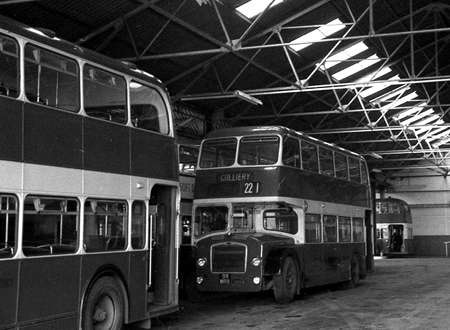
……and of course it be came more complicated when MGO & MDT swapped vehicles, as they often did. For a short period of deliveries MGO had 2 tracks and when such examples were moved over to the MDT fleet, as in 1969 with this 1961 FS6G, there was the need for special linen so that a 2 track blind could show 3 digits.
Berisford Jones
19/05/14 – 15:37
John D,
Flattered as I am I regret that I cannot add to the discussion about the turning arrangements at Scholes Park Road. My childhood memories were of Whitby. However I can claim some connections in the area – my Uncle & Aunt lived in Ryecroft Road (just off Scholes Park Road and later my cousin on Scholes Park Road itself. In later life after marriage and a transition from transport to equestrian interests I have been a regular attender and exhibitor at Burniston Show which has occupied a number of sites in the locality.
Gordon Green
20/05/14 – 16:36
When, as a boy, I stayed with relatives in Newby in the summer, via Northstead the 116 was worked by single deckers usually an "L". It terminated at Five Lane Ends and reversed around the corner to the stop. I don’t think it was a cross-town service then.
I have a Summer 1951 timetable for the town services (100/1/2/3/4/5/6/07/9/10/13). The 113 ran between the Railway Station and Scholes Park Road – on reaching Burniston Road. The return route is just given as the reverse of the outward route. the 109 was the seafront service whilst the 110 was the Oliver’s Mount service.
Malcolm Wells
22/05/14 – 07:21
I commented earlier on the subtle differences between the supposedly same red or green liveries borne by the Tilling companies’ buses. And, of course, there were all those other variations which Brendan and others have referred to. I then stated that the NBC red or green was just plain boring. I still think that’s generally true compared with what went before, but I have to say that John’s picture of United 547 does indeed look smart. I guess it’s because the paintwork still has a shine to it, and of course the ECW bodied FLF also exudes a certain quality. However, whether they were in smart or faded red, there was little to distinguish a United FLF from, say, a Hants and Dorset FLF in NBC days. Uniformity reigned supreme!
Michael Hampton
22/05/14 – 07:23
When at college and university I spent the summers of 1966, 7 and 8 as a conductor in Scarborough. On the 113 at Scholes Pk Road the conductor was meant to use a whistle to signal to the driver when reversing. The snag was he couldn’t hear it so we always used the bell! Some drivers reversed back onto the main road, but most reversed from the main road.
The service had three buses providing a 10 minute service. I still have my staff timetable for 1968 – There was a 10 min service from 07:00(9:30 on sun) – 23:10. For some reason the 23:00 terminated at Northstead. All the theatres had special journeys and I remember the Futurist had the Black and Whites at least two of the years I was in United uniform!
Mr Anon
22/05/14 – 07:24

These recollections of Scarborough and the town services, and especially the sea front service with those full fronted coaches have brought back some very pleasant memories of childhood holidays. I took this shot of BBL61 (LHN 936) opposite Corner Café in July of 1961 when I was just thirteen, with an old Agfa camera that my father acquired in Germany during the war. I well remember some of the town services turning round at a roundabout opposite the main harbour, and the buses threading their way through some of the narrow shopping streets leading away from the sea front and up out of the town. Some of the best holidays ever.
Dave Careless
26/05/14 – 09:33
Great picture Dave! The destination blind shows ‘The Mere’ which many will recall is where one could sail on the Hispaniola and dig for dubloons on Treasure Island. One of the ‘pirates’ did have only one leg – perhaps a war injury – a prerequisite for such a job? My Dad or Uncle knew ‘Ben Gunn’ on the island!
For many years the buses on services 100 and 101 showed ‘Edgehill Road’ as the destination which meant little or nothing to holidaymakers. I recall ‘The Mere’ starting to appear on the buses at some stage.
In the 1960s another uncle and auntie lived in a bungalow on Mere Lane overlooking The Mere, a smart property then but absolutely fantastic now, so we regularly travelled on the buses to visit.
The last time I looked The Mere was devoid of all the little buildings/kiosks for boat hire, ice creams etc. There was once an area for water ski-ing.
David Slater
26/05/14 – 11:25
Regarding the route numbers in question, I have a 1962 faretable in which the 113 was a local service from Railway Station to Burniston Road (Scholes Park Road).
The 116 was a cross-town route from Eastfield Estate (Overdale) to Newby (Four Lane Ends), but there were no short distance local fares for stages between Steamer Moor Road and Cleveland Avenue (presumably the protected area)
David Todd
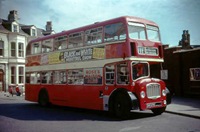 Vehicle reminder shot for this posting
Vehicle reminder shot for this posting
27/05/14 – 14:03
Fascinating recollections of Scarborough town services back in the day; I think my favourite United route in the area though was the 111, which ran from Scarborough, through Filey, and on to Bridlington if I remember rightly. I can’t even think about it without suddenly smelling fish and chips, or seeing a revolving rack of ‘saucy’ seaside postcards.
Dave Careless
I am not a bus aficionado, just a casual visitor to this site. I remember Eastern National having some ‘stretched’ versions of the FLF6B or Lodekka. The rear side windows (quarterlights?) were wider, making the bus about a foot longer. However, I have not seen any photographs of them on this site. They were a very fast bus.
Martin Robinson
26/09/14 – 05:43
David C – you are right about the 111 service via Speeton and Hunmanby. It did indeed run to Bridlington where it terminated in its own little United bus station on the Promenade (east side almost opposite the superb EYMS station) – well, I say bus station but it was actually a generous forecourt in front of the booking/enquiry office, and is now the outside seating for a small cafe. Like you, fish and chips, saucy postcards, and Joyland Amusements are my treasured memories of Bridlington in the 1940s/50s where I stayed often with Grandma and Aunty Doris – now where are the Kleenex tissues (other brands are available).
Chris Youhill
